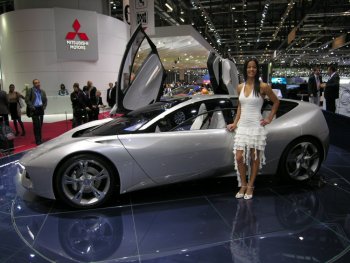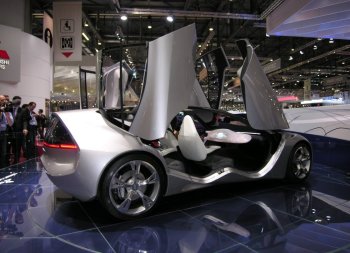
 |
Pininfarina unveiled
their latest show car, called the Sintesi, a
four-seater which explores future packaging
solutions around Quadrivium fuel cell
technology, to an interested audience in
Geneva. |
|
 |
|
|
|
Pininfarina unveiled their latest
show car, called the Sintesi, to an interested audience
at the Geneva Motor Show last Tuesday. The Sintesi
continues Pininfarina’s recent line-up of concept cars,
in particular combining the values of the Nido and
Birdcage 75th. As the name suggests, Sintesi is a
sythesis of Pininfarina’s design values, uniting
sportive nature with practicality.
The Sintesi is a four-seater which
explores future packaging solutions around Quadrivium fuel
cell technology, distributing the engineering in a more
fluid-like manner throughout the chassis which has generated
new packaging solutions for a roomier interior and a more
dynamic exterior design. The interior space, which is
comparable to that of a Maserati Quattroporte, is housed
within an extremely aerodynamic body measuring a drag
coefficient of only Cd 0.27. This so-called “Liquid
Packaging” also improves weight distribution and lowers the
centre of gravity, to enhance driving characteristics.
In contrast to many concept cars which
were unveiled at Geneva, the Pininfarina Sintesi focuses on
a timeless form, rather than complicated ‘over styled’
detailing, which is a recurring malady with overstaffed
modern-day style studios.
The first design sketches of the car were
produced by Nazzareno Epifani. The young designer, who
arrived at Pininfarina after studies at the IED in Turin,
first explored the general shape, producing a monolithic
form before applying the detailing. The exterior, in
particular the glasshouse area, demonstrates a very strong
graphic image. Slim LED lighting modules at the front and
rear, developed by Osram, add to the simplicity of the
monolithic form. Giuseppi Randazzo was the main Chief
Designer on the project along with Lowie Vermeersch,
Pininfarina Design Director. Contributions came from Jason Castriota,
Pininfarina Chief Designer.
The exterior of the car presents a clear
symbiosis of technology and sculpture. This is continued
inside, where the interior space is incorporated into the
chassis structure. The seats in particular underline this
split-level design, with the seat backs being sensually
cantilevered away from the base, and also being trimmed in
lighter leather.
Lowie Vermeersch, the Belgian-born
designer who has been working at Pininfarina since 1997,
explains the interior features. “The dashboard, which is
made from translucent plastic, contains a honeycomb
structure which has been topographically engineered to
ensure maximum strength and minimal material use. An
identical form of design and engineering has been applied to
the interior lighting module which runs along the roof of
the car. This is a highly natural design process, where
simplicity has played a very important role.”
The dashboard itself uses the latest
touch-screen technology, and the car is furthermore linked
to a handheld device. The floor pan section is wave-like in
profile, which is repeated in the lower door shut line,
which according to Jason Castriota suggests “a magic-carpet
ride.” Despite this, Pininfarina are certain that the
technology on the Sintesi is no fantasy, and showcases
features which could be applied to production cars within
the next decade.
by James
Granger
|